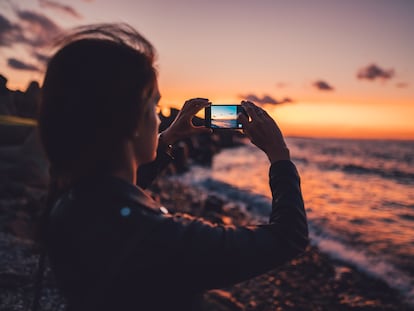Four tips to help your cellphone survive the summer
With smartphones prone to breaking down in July and August, we have put together some recommendations on how to ensure your device does not succumb to the heat

Summer heat doesn’t just affect people; electronic devices, and especially smartphones, also suffer from high temperatures. In fact, most breakdowns happen in summer. According to a survey carried out by Portaltic/EP, one in three breakdowns takes place between July and August, and nearly always, the cause is related to the device being misused in heat and humidity. While the degree of this problem varies, nearly always it is preventable. Here are some tips to ensure your cellphone survives the summer.
Keep it out of the sun
If a cellphone is exposed to the sun, it will rapidly heat up, and this will affect its operation. In fact, the specification sheets of all electronic devices list their optimal temperatures for use, which, in the case of smartphones, is usually between zero and 40 degrees Celsius (32ºF to 104ºF). Above that range, there is a good chance that your battery will be damaged (this can happen once it hits 50ºC, 122ºF), the screen will explode or the electronics will be affected. If you notice that your cellphone is getting too hot, turn it off until it is back to a normal temperature.
Charge the battery without the cellphone case
It is completely normal for cellphones to heat up while charging, especially if fast or wireless charging modes are being used. But if it gets too hot, measures must be taken. Two of the most effective are removing your cellphone’s case when charging and not using it while it is charging.
That said, many devices have in-built measures to avoid overheating. Samsung phones, for example, automatically dim the screen and slow down the device. Apps are even closed down, until the phone is only able to make emergency calls. On iPhones, meanwhile, charging slows down or stops until the phone cools down, the screen dims or turns off, and the device goes into a low-power mode which causes coverage to drop.
Avoid energy-intensive functions
Cellphones heat up if they are being used for energy-intensive tasks. If it is a hot day, it’s a good idea to avoid energy-draining activities such as playing video games or editing videos or images. Experts also recommend reducing screen brightness, deactivating Bluetooth and GPS, closing applications if they are not being used, and turning off data.
Don’t put your phone in the water
It’s likely that your smartphone has some kind of certification that says it is water-resistant. But be careful! Although technically, a cellphone can be submerged in water, many manufacturers warn the feature is just designed for accidents. In other words, the idea is not to sit in the pool with your cellphone. Always keep in mind that certification tests are carried out in a laboratory and with fresh water: both salt and chlorine can damage a device. So if you do want to use your phone in the pool, make sure it has a special sealed cover.
Sign up for our weekly newsletter to get more English-language news coverage from EL PAÍS USA Edition
Tu suscripción se está usando en otro dispositivo
¿Quieres añadir otro usuario a tu suscripción?
Si continúas leyendo en este dispositivo, no se podrá leer en el otro.
FlechaTu suscripción se está usando en otro dispositivo y solo puedes acceder a EL PAÍS desde un dispositivo a la vez.
Si quieres compartir tu cuenta, cambia tu suscripción a la modalidad Premium, así podrás añadir otro usuario. Cada uno accederá con su propia cuenta de email, lo que os permitirá personalizar vuestra experiencia en EL PAÍS.
¿Tienes una suscripción de empresa? Accede aquí para contratar más cuentas.
En el caso de no saber quién está usando tu cuenta, te recomendamos cambiar tu contraseña aquí.
Si decides continuar compartiendo tu cuenta, este mensaje se mostrará en tu dispositivo y en el de la otra persona que está usando tu cuenta de forma indefinida, afectando a tu experiencia de lectura. Puedes consultar aquí los términos y condiciones de la suscripción digital.











































